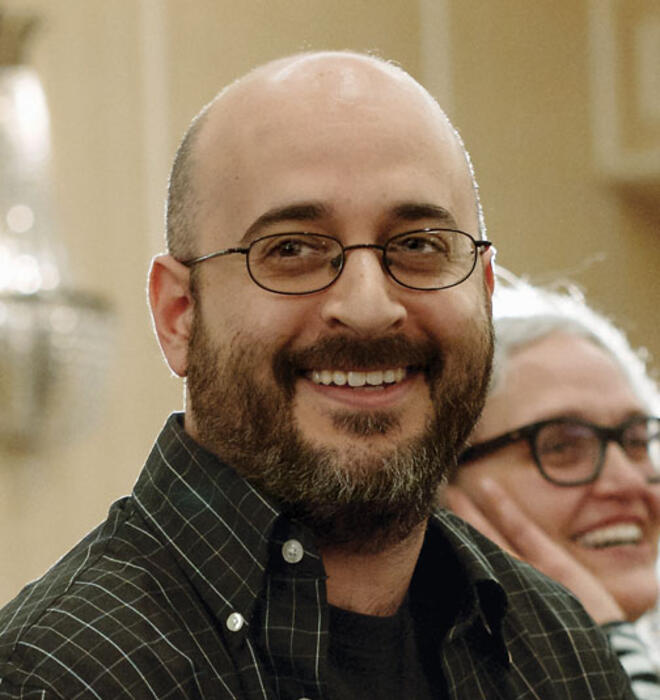
Four down
At the American Crossword Puzzle Tournament, there is no match for Dan Feyer ’99
“The nice thing about doing a crossword puzzle is, you know there’s a solution.”
— Stephen Sondheim
SORRY, MR. SONDHEIM, but that is small comfort. I may know that the name of the second-longest river in Belgium contains five letters, but that doesn’t mean I can figure out what they are. (I’ll spare you from running to Google: It’s the Meuse.) When it comes to crosswords, most of us spend hours staring at the blank boxes of the Sunday New York Times puzzle, drumming a pencil tip on the kitchen table. What’s a seven-letter word meaning “hung up on”? Try: stumped.
The 572 contestants at the 36th annual American Crossword Puzzle Tournament feel differently. The tournament, held in early March at the Brooklyn (N.Y.) Marriott, is the largest crossword competition in the world, indeed the largest puzzle tournament of any kind. More than a dozen Princetonians were among the 572 competitors, with three finishing among the top six in the toughest “A” division. And for the fourth year in a row, Dan Feyer ’99 walked off with the $5,000 first prize, putting yet another trophy on a shelf that already is groaning with them.
Want to feel bad? Feyer can whip through the Monday Times puzzle, traditionally the easiest, in about 90 seconds, and has been known to knock out the Saturday puzzle, the hardest, in less than three and a half minutes. (Although the celebrated Sunday puzzle is the biggest of the week, it is not the hardest.) That is barely enough time to get warmed up, so Feyer does three other puzzles daily (usually ones in The Los Angeles Times, The Christian Science Monitor, and Newsday), and more on the weekends, and matches his times against other top solvers on his blog, dandoesnotblog.blogspot.com.
Even that does not a champion make, so Feyer does another dozen or more crossword puzzles every day, just to stay sharp, and estimates that he has solved at least 40,000 in the six and a half years since he started doing them seriously. He thinks that he has close to 50,000 unsolved puzzles on his computer, many of which aren’t worth doing because they are too easy. His job as pianist and music director for theater productions provides him with lots of down time, but he says he sometimes finishes 10 puzzles on his tablet just on the half-hour subway ride to work. He prefers solving online because he can type faster than he can scribble; working on his tablet also shaves off seconds because the clue usually is highlighted when the cursor moves over the answer blocks, so he does not have to hunt for it. “Being able to immediately spot the desired clue is a key aspect of speed-solving technique,” he explains. “You have to look for clues 100 times or so in a normal puzzle, so any time not thinking or writing adds up!” When he works on paper, he favors a mechanical pencil; and, yes, he sometimes uses the eraser.
Although Feyer did the odd Sunday crossword in college, solving did not become an obsession until he saw Wordplay, a 2006 documentary about the tournament. Stella Daily Zawistowski ’00, this year’s fifth-place finisher, started doing crosswords at Campus Club as a way to avoid working on her junior papers. (Now a copywriter for a pharmaceutical firm, she wrote about the 2003 tournament for PAW. See “War of Words,” April 23, 2003.) Kiran Kedlaya *97, who finished sixth, got hooked as a graduate student. When he discovered that the tournament was being held relatively nearby in Stamford, Conn., he entered on a whim and has been competing on and off ever since.
Many crossword aficionados have mathematical or musical backgrounds, which does not surprise Kedlaya, now a mathematics professor at UC-San Diego. “Crossword puzzles do test knowledge,” he says, “but they also test your ability to combine strings of letters in an unexpected way, and a lot of mathematics is about the ability to combine things in unexpected ways.” Feyer has said that the same part of his brain that helps him sight-read music helps him to see how words will fit into a puzzle grid. After winning his first American Crossword Puzzle Tournament in 2010, he told The New York Times that as he begins to fill in a grid, he starts to recognize what the words will be based on just a few letters, without even looking at the clues.
THE FIRST CROSSWORD PUZZLE, diamond-shaped and without the internal black boxes, was published in the New York World on Dec. 21, 1913. Other newspapers followed, and the puzzles soon became a national obsession. The Times, characteristically, was slow to follow the crowd; it did not run its first Sunday puzzle until 1942 (publisher Arthur Hays Sulzberger thought it would give readers something to do during World War II air-raid blackouts), and daily puzzles did not appear until 1950.
Today, tens of thousands of crossword puzzles are produced each year in all shapes, sizes, and themes, but the ones in the Times remain, like the Gray Lady herself, the puzzles of record. Bill Clinton does them religiously. So do — or did — Ken Burns, Jon Stewart, Jude Law, Leonard Bernstein, Beverly Sills, and Moss Hart. Norman Mailer once described his morning puzzle ritual as “how I comb my brain.” (Sondheim, however, dismisses the Times puzzle as “a mechanical test of tirelessly esoteric knowledge ... sending you either to Webster’s New International or to sleep,” and prefers a more difficult form known as a cryptic crossword.)
What makes crosswords so addictive? Bob Klahn ’66, who bills himself as “The Universe’s Toughest Clue Writer,” directs the CrosSynergy Syndicate, which provides daily crossword puzzles to The Washington Post and many other papers, books, and websites. He believes puzzles are popular for many reasons, providing a challenge, a diversion, an escape, and a sense of accomplishment (or, depending on your skill level, frustration).
Despite the common belief that doing crosswords sharpens mental acuity (the oft-cited assertion that it can help stave off Alzheimer’s, though, is just a myth), the talents that make a good solver don’t necessarily transfer to other types of puzzles. Feyer admits that he is not particularly good at Scrabble, which calls on a very different skill set. Zawistowski says she is “terrible” at Sudoku. One would think that crossword mavens would also be trivia buffs, but that is not always the case. While some Jeopardy! contestants prep by poring over the World Almanac, crossword addicts might know the capital of Mauritania (Nouakchott) because they have seen it before in clues.
WILL SHORTZ, the Times’ legendary crossword editor, organized the first American Crossword Puzzle Tournament in 1987 and has run it ever since. Contestants this year ranged in age from 17 to 86 and came from as far away as Hawaii and Great Britain. They were divided evenly between men and women. About 40 percent said this was their first tournament, but another 20 percent had competed there at least 10 times. Tom Weisswange ’94, a high school math teacher, is a 19-year veteran, while Jenni Levy ’82, a hospice medical director, had attended only once before.
Zawistowski, back for her 13th tournament, had her game face on. “If I don’t make any mistakes, I have a chance to finish in the top 10,” she reasoned before the first puzzle. “If I hurry, I’ll make mistakes and I’ll have no chance.” Not everyone, however, was gunning for the top. Kelly Ann Smith *95, a software engineer, said that her goal was just to finish all seven puzzles. “I’m really good compared to most people,” she said. “Here, I’m a ‘C.’”
Competitive pressures do not keep the tournament from being a social event. David Hodes ’63 attended with his daughter, Laura Hodes Dove ’92. Mike Molyneux ’76 took the train down from Boston with four friends and caught up with others he sees once a year. The tournament, he says, “is a reunion.” Levy, who recalls doing puzzles as a little girl with her mother and grandmother, echoes that sentiment. “It’s wonderful to find a community,” she says. “And they have the best puzzles!” Speaking of communities, Juli Robbins Greenwald ’83, a B-level contestant who also has competed in several amateur bodybuilding tournaments, sees odd similarities between the two: Both provide “a peek into a weird, bizarre subculture.”
Subculture, indeed. The Marriott ballroom was filled with people attired in puzzle hats, scarves, shirts, jackets, and umbrellas. One woman was dressed in crosswords print from head to foot: cap, pajamas, and slippers. A man wore a replica Mel Ott baseball jersey (Ott’s name — three letters, starting with a vowel — is a favorite among puzzle constructors). Out in the lobby, vendors hawked crossword mugs, books, pens, pencil sharpeners, and websites — even a novel about crosswords.
Regardless of experience or skill level, all contestants did the same seven puzzles, six on Saturday and one on Sunday morning. Scores were based on the time it took to finish, with deductions for wrong answers and unanswered clues. Puzzle creators are rock stars to this crowd. When Shortz announced that a puzzle had been designed by Patrick Blindauer, a self-described “crossword fiend,” the contestants let out a collective groan. One woman got up, turned in her blank answer sheet, and announced that she was going upstairs to take a shower.
That puzzle also stumped Smith, who started but could not finish. It did not faze Feyer, whose pencil never seemed to leave his sheet and who finished in about as long as it took him to write down all the letters. During breaks, while other competitors relaxed or socialized in the lobby, Feyer sat in his back-row seat and did ... more puzzles, to keep himself in the groove. He estimates that he did a dozen extra puzzles on Saturday alone.
The top three finishers in the A, B, and C divisions advanced to the Sunday afternoon finals. They competed on stage, writing in marker on a large whiteboard while wearing noise-canceling headphones in case anyone in the audience shouted out an answer. (There were no finals for the less competitive D, E, and rookie tiers.) Everyone answered the same puzzle, but the clues were harder at each level. The answer to 1-across in all three final rounds, for example, was “Snapbrim.” C-division finalists got the clue “Adjustable fedora feature.” For the B division, it was “Cap part,” and for the A division, the devilishly ambiguous “Tipping point?”
When Shortz called, “Begin,” to kick off the A-division final, Feyer did something entirely out of character. For nearly 30 seconds he simply stared at the board without answering. With so much on the line, he wanted to read the clues carefully and think them through.
The tournament is a place for fanatics, so it is fitting that “fanatics” proved to be a hurdle on his way to title number four. It was the answer to 27-across (an eight-letter word for “Ones bearing high interest”) and it stumped him for a moment, he admits — both “high” and “interest” have multiple meanings. One of the other finalists, Tyler Hinman, who won five consecutive titles before Feyer unseated him in 2010, appeared to take an early lead, filling in most of the right side of his board while Feyer still was working on the lower-right quadrant. But once Feyer cracked the difficult clue, the rest of his board fell into place. He finished in 10:41, not as fast as his other winning times, but it was a harder puzzle. As he wrote on his blog later, “The playoff puzzle put up a bigger fight than it ever had before.”
Tempting as it is to call these whizzes “machines,” they aren’t. They’re better. Although many easy puzzles are designed by computers, computers still have trouble solving them. Puns and other linguistic tricks trip them up. The top computer puzzle-solving program, called Dr. Fill (get it?), finished the tournament in 92nd place and could not solve the final puzzle using the A-level clues.
Schedules permitting, all the Princeton participants hope to return next year. As for Feyer, he was planning to use some of the $5,000 prize money to pay for a post-tournament vacation to Puerto Rico, but he returned immediately to his daily ritual of puzzle solving. He expects to defend his title next year. There are still mountains to climb, particularly the tournament record of seven championships, he says: “I don’t think I would want to retire before that.”
Mark F. Bernstein ’83 is PAW’s senior writer.


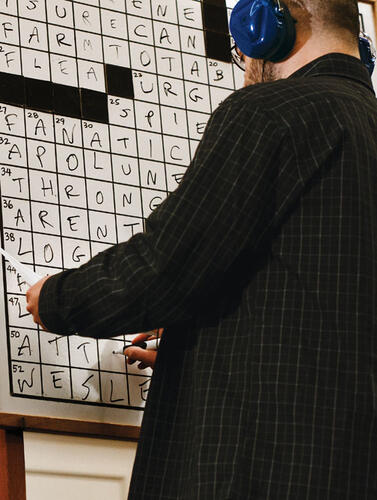
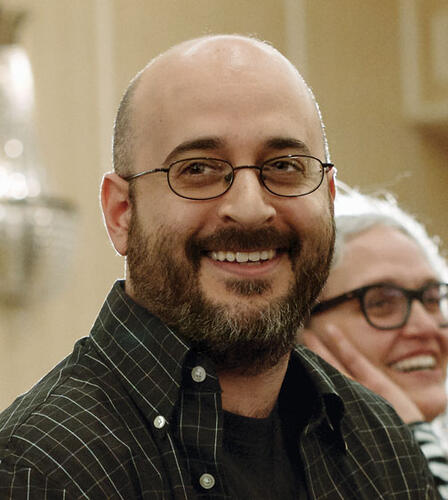
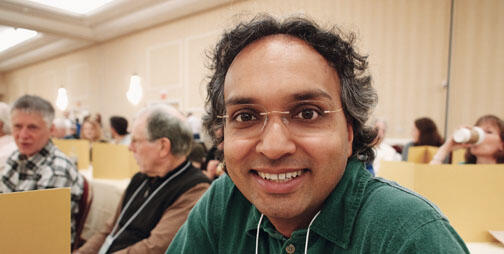
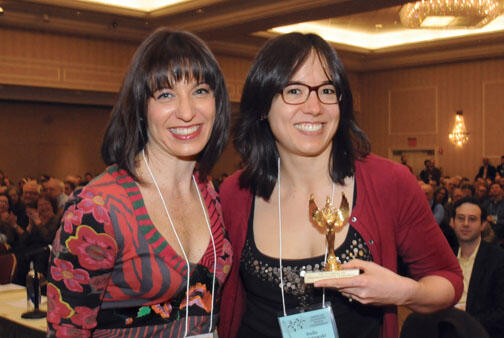




No responses yet